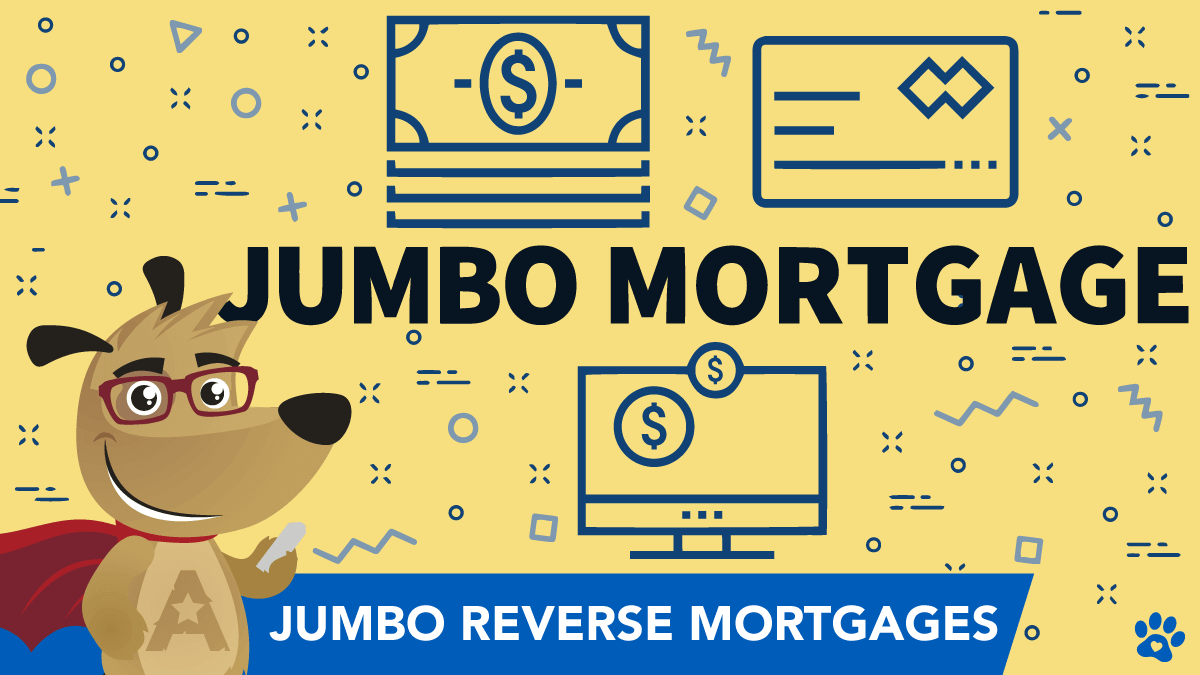2025 Jumbo Reverse Mortgage Guide: Top Lenders, Rates & Loan Limits
 |
Michael G. Branson, CEO of All Reverse Mortgage, Inc., and moderator of ARLO™, has 45 years of experience in the mortgage banking industry. He has devoted the past 20 years to reverse mortgages exclusively. (License: NMLS# 14040) |
 |
All Reverse Mortgage's editing process includes rigorous fact-checking led by industry experts to ensure all content is accurate and current. This article has been reviewed, edited, and fact-checked by Cliff Auerswald, President and co-creator of ARLO™. (License: NMLS# 14041) |
In 2025, the landscape of reverse mortgages continues to evolve, with jumbo reverse mortgages (also known as proprietary or private reverse mortgages) emerging as a significant option for homeowners with high-value or non-conforming/non-FHA insured properties.
In this article, we will dissect the significant differences between jumbo and FHA-insured reverse mortgages, clarifying why and when a jumbo reverse mortgage could be the right choice for you. We will also dive into the key benefits, along with a balanced discussion of potential risks and rewards.
Whether you are a homeowner, a financial advisor, or simply interested in the latest trends in mortgage finance, this article will equip you with the knowledge about the lenders, rates, and loan limits pertinent to 2025’s reverse mortgages.
What is a Jumbo Reverse Mortgage?
A jumbo reverse mortgage is a type of reverse mortgage for homeowners with high-value properties or properties that may not conform to HUD/FHA insurance requirements.
While traditional reverse mortgages are insured by the Federal Housing Administration (FHA), a division of the Department of Housing and Urban Development (HUD), FHA and HUD are used interchangeably through the Home Equity Conversion Mortgage (HECM).
In contrast, jumbo reverse mortgages are not insured by FHA or HUD. Instead, they are known as proprietary or non-FHA reverse mortgages. The jumbo programs also have their own underwriting requirements, meaning that not all properties that qualify for FHA financing can be used for the jumbo programs.
The private programs set their own underwriting parameters, and therefore, they will accept many property, borrower, and loan scenarios that the FHA underwriting requirements may not accept.
Jumbo reverse mortgages offer loan amounts much higher than those available through FHA. The FHA program limits borrowers to a percentage of the HUD maximum lending limit of $1,209,750 or the appraised value (whichever is less).
Based on interest rates and the borrowers’ ages, the FHA program’s maximum loan amount is significantly lower than the current maximum of $4,000,000 for jumbo programs.
This means homeowners with higher valued homes can borrow more money than they could with a standard HECM loan that would otherwise be capped.
Moreover, we will also discuss some situations where the jumbo program might work best for borrowers with properties valued at or below the HECM limit due to borrower or property parameters.
The exact percentages and figures will vary depending on several factors, including interest rates, borrowers’ ages, and home value.
Did You Know? Jumbo reverse mortgages can go as high as $4 million, more than three times the FHA lending limit of $1,209,750
Understanding Jumbo Reverse Mortgages
Several lenders offer jumbo reverse mortgages, and the details can vary between lenders. These are proprietary loans, meaning they do not need to follow the rules of the Department of Housing and Urban Development (HUD).
Jumbo reverse mortgages can offer unique features that FHA-insured Home Equity Conversion Mortgages (HECM) do not, such as:
- Allowing borrowers who are younger than the HECM minimum age of 62 (where state laws permit)
- Enabling the use of a non-FHA-approved condo unit as collateral
- Providing the option to take out the full loan amount as a lump sum at closing, with fewer restrictions than HECMs
A key difference is that jumbo reverse mortgages do not require mortgage insurance premiums, which are a cost associated only with FHA-insured loans.
Despite these differences, jumbo reverse mortgages are also similar to HECMs in some ways. They typically require reverse mortgage counseling and may offer various disbursement options, like a lump sum or a line of credit. These loans allow borrowers to access their home equity while continuing to live in their homes.
Some jumbo programs allow borrowers as young as 55 to qualify, seven years earlier than the FHA HECM program.
2025 Jumbo Reverse Mortgage vs. HECM: Key Differences at a Glance
| Feature | Jumbo Reverse Mortgage | FHA HECM Reverse Mortgage |
|---|---|---|
| Minimum Age | 55 (varies by lender and state) | 62 |
| Max Lending Limit | Up to $4,000,000 (some programs may allow more) | $1,209,750 (HUD national limit) |
| Eligible Property Types | Single-family, FNMA-warrantable condos, 1–4 units | Single-family, HUD-approved condos, 1–4 units |
| Upfront Access | 100% lump sum available at closing | Limited (typically 60% or obligations + 10% in first year) |
| Line of Credit Features | 10-year draw period (no lifetime growth) | Lifetime access with credit line growth |
| FHA Insurance | No mortgage insurance premiums (MIP) | Yes, MIP required (upfront and annual) |
| Younger Spouse Protections | Varies by lender – not guaranteed | Fully protected by HUD regulations |
| Use for Home Purchase | Yes | Yes |
| Note: *HECM lump sum capped at 60% of Principal Limit or obligations + 10% in first 12 months. | ||
2025 Jumbo Reverse Mortgage LTV by Age: How Much You Get
| Youngest Borrower Age | LTV % (Loan-to-value) | Loan Amount on $1M Home | Loan Amount on $2M Home | Loan Amount on $3M Home |
|---|---|---|---|---|
| 55 | 39.10% | $391,000 | $782,000 | $1,173,000 |
| 56 | 39.30% | $393,000 | $786,000 | $1,179,000 |
| 57 | 39.50% | $395,000 | $790,000 | $1,185,000 |
| 58 | 39.70% | $397,000 | $794,000 | $1,191,000 |
| 59 | 40.10% | $401,000 | $802,000 | $1,203,000 |
| 60 | 40.40% | $404,000 | $808,000 | $1,212,000 |
| 61 | 40.70% | $407,000 | $814,000 | $1,221,000 |
| 62 | 41.00% | $410,000 | $820,000 | $1,230,000 |
| 63 | 41.40% | $414,000 | $828,000 | $1,242,000 |
| 64 | 41.90% | $419,000 | $838,000 | $1,257,000 |
| 65 | 42.40% | $424,000 | $848,000 | $1,272,000 |
| 66 | 42.90% | $429,000 | $858,000 | $1,287,000 |
| 67 | 43.50% | $435,000 | $870,000 | $1,305,000 |
| 68 | 44.00% | $440,000 | $880,000 | $1,320,000 |
| 69 | 44.60% | $446,000 | $892,000 | $1,338,000 |
| 70 | 45.30% | $453,000 | $906,000 | $1,359,000 |
| 71 | 46.00% | $460,000 | $920,000 | $1,380,000 |
| 72 | 46.80% | $468,000 | $936,000 | $1,404,000 |
| 73 | 47.70% | $477,000 | $954,000 | $1,431,000 |
| 74 | 48.70% | $487,000 | $974,000 | $1,461,000 |
| 75 | 49.70% | $497,000 | $994,000 | $1,491,000 |
| 76 | 50.80% | $508,000 | $1,016,000 | $1,524,000 |
| 77 | 51.60% | $516,000 | $1,032,000 | $1,548,000 |
| 78 | 52.40% | $524,000 | $1,048,000 | $1,572,000 |
| 79 | 53.40% | $534,000 | $1,068,000 | $1,602,000 |
| 80 | 54.40% | $544,000 | $1,088,000 | $1,632,000 |
| 81 | 55.60% | $556,000 | $1,112,000 | $1,668,000 |
| 82 | 56.90% | $569,000 | $1,138,000 | $1,707,000 |
| 83 | 58.10% | $581,000 | $1,162,000 | $1,743,000 |
| 84 | 59.00% | $590,000 | $1,180,000 | $1,770,000 |
| 85 | 60.00% | $600,000 | $1,200,000 | $1,800,000 |
| 86 | 60.30% | $603,000 | $1,206,000 | $1,809,000 |
| 87 | 60.60% | $606,000 | $1,212,000 | $1,818,000 |
| 88 | 60.80% | $608,000 | $1,216,000 | $1,824,000 |
| 89 | 61.00% | $610,000 | $1,220,000 | $1,830,000 |
| 90-100 | 61.10% | $611,000 | $1,222,000 | $1,833,000 |
2025 Jumbo Reverse Mortgage Rates and Limits
| Rate Type | Rate/APR (Accurate as of 10/15/2025) | Lending Limit |
|---|---|---|
| Fixed | 7.990% (8.594% APR) | $4,000,000 |
| Fixed | 8.950% (9.029 % APR) | $4,000,000 |
| Fixed | 8.990% (9.602% APR) | $4,000,000 |
| Fixed | 9.240% (9.319% APR) | $4,000,000 |
| Adjustable | 9.285% (5.625 Margin) | $4,000,000 |
| Adjustable | 9.409% (5.749 Margin) | $4,000,000 |
| Adjustable | 9.410% (5.750 Margin) | $4,000,000 |
| Adjustable | 9.535% (5.875 Margin) | $4,000,000 |
| Adjustable | 9.650% (5.990 Margin) | $4,000,000 |
| Adjustable | 9.660% (6.000 Margin) | $4,000,000 |
| Note: Fixed: Lump Sum only. Adjustable: Lump Sum or Line of Credit. APR for a 70-year-old, $1M loan in CA. | ||
Expert Insight from Michael Branson, CEO: “If your home is well above FHA limits, a jumbo loan can unlock far more equity while still protecting you with non-recourse features.”
Pros & Cons of Jumbo Reverse Mortgages
For those considering a jumbo reverse mortgage, there are some pros and cons – most of which apply to all reverse mortgage programs, private or FHA-insured.
Did You Know? Jumbo loans are still non-recourse, meaning you or your heirs can never owe more than the home’s value when sold.
History and Current Market Outlook
The jumbo reverse mortgage market has evolved and has been influenced by various factors. After the 2008 housing crash, many jumbo reverse mortgage products disappeared.
However, several new jumbo products have been introduced in recent years, offering different rates, terms, and features, thanks to low interest rates and changes to the FHA lending limit.
If you are considering a jumbo reverse mortgage, comparing lenders on the specific terms they offer is essential. Important details include the maximum amount you can borrow, how you will receive the loan proceeds, and the protections available for non-borrowing spouses, if applicable.
Understanding these factors will help you make an informed decision.
Ready to Tap Into More Home Equity with a Jumbo Reverse Mortgage? At All Reverse Mortgage, Inc. (ARLO™), we offer real-time rate quotes, personalized loan estimates, and side-by-side comparisons between jumbo and HECM programs, backed by 20+ years of trusted expertise and a 4.9/5-star rating. Call us Toll-Free at (800) 565-1722 or click here to get your free quote and explore your jumbo loan options with confidence.
FAQs
What is a jumbo reverse mortgage?
What is the difference between a HECM and a jumbo reverse mortgage?
What is the difference between jumbo and proprietary loans?
“Jumbo” is a reference to a “large loan amount.” Where jumbo reverse mortgages are proprietary by nature, proprietary reverse mortgages are not necessarily jumbo. Some proprietary reverse mortgages are offered on homes with values as low as $450,000. In contrast, Jumbo programs usually benefit those high-valued homes more than the HUD lending limit of $1,209,750.
How much can you get from a jumbo reverse mortgage?
What are the rates for jumbo reverse mortgages?
What is the maximum jumbo reverse mortgage?
Can you get a jumbo reverse mortgage line of credit?
What are the disadvantages of a jumbo reverse mortgage?
What lenders offer jumbo reverse mortgages?
How long does it take to process a jumbo reverse mortgage?
What about my property tax and insurance with a jumbo reverse mortgage?
With a jumbo reverse mortgage, are the beneficiaries liable if the property is “underwater”?
Can you have more than one jumbo reverse mortgage?
Can I rent rooms privately, with a rental company, or Airbnb if we have a jumbo reverse mortgage?
Additional Resources:
- Read my article published at Forbes.com, “The Evolution Of Jumbo Reverse Mortgages.”

Have a Question About Reverse Mortgages?
Over 2000 of your questions answered by ARLO™
Ask your question now!




 Michael G. Branson
Michael G. Branson Cliff Auerswald
Cliff Auerswald


August 19th, 2025
August 28th, 2025
January 19th, 2023
January 31st, 2023
July 15th, 2022
July 19th, 2022
February 15th, 2022
February 15th, 2022
February 9th, 2022
February 15th, 2022
August 20th, 2021
August 24th, 2021
September 22nd, 2020
September 22nd, 2020
October 1st, 2019
October 6th, 2019